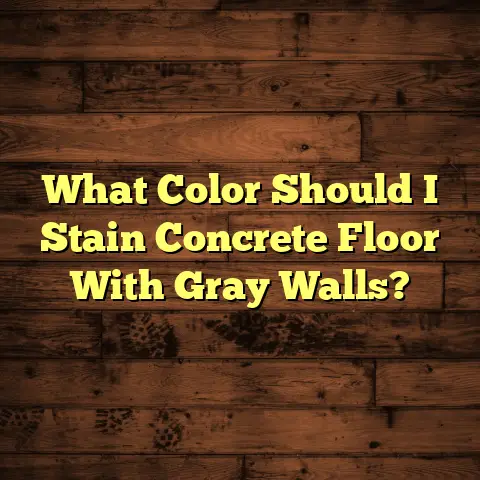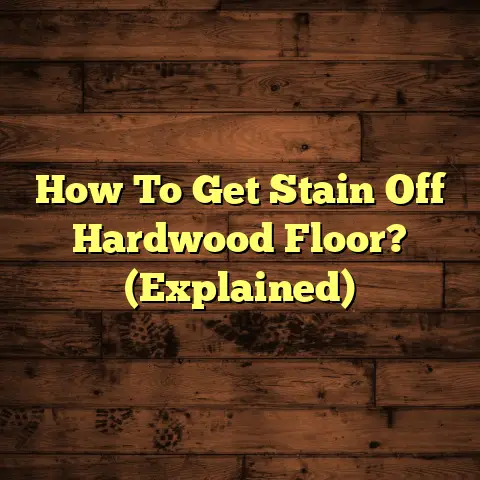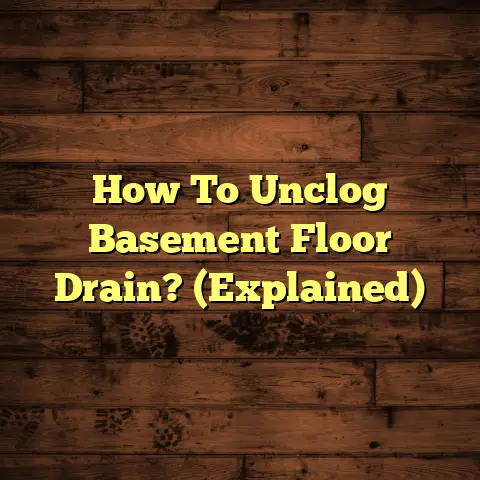Epoxy For Concrete Floors: Basketball Court Guide? (Explained)
I’ve faced numerous challenges as a flooring contractor over the years, but one that stands out is creating the perfect surface for a basketball court.
The excitement of a well-designed space is always tempered by the significant obstacles that come with it, especially when working with concrete floors.
Why Epoxy?
I remember my first basketball court project—it was a mix of excitement and anxiety.
I wanted to create a surface that not only looked great but also provided the durability and traction needed for intense games.
After researching various options, I discovered epoxy coatings.
What initially drew me to epoxy was its ability to transform a plain concrete slab into a vibrant, durable playing surface.
When you think about it, basketball is a fast-paced sport that puts a lot of stress on the flooring.
Players are constantly running, jumping, and sliding.
The floor needs to withstand this abuse while also providing the right amount of grip and bounce.
That’s where epoxy shines.
My Experience with Epoxy
The first court I installed epoxy on was for a local community center.
The concrete was in pretty rough shape, showing signs of wear and tear from years of use.
I knew that simply painting over it wouldn’t suffice, so I opted for an epoxy coating.
The preparation was key.
I started by thoroughly cleaning the concrete and filling any cracks.
This step is crucial because if you don’t prepare the surface correctly, the epoxy won’t adhere properly, leading to peeling or bubbling down the line.
Once the surface was ready, I mixed the epoxy according to the manufacturer’s instructions.
The application process was surprisingly straightforward.
I used a roller for large areas and a brush for edges and corners.
It was fascinating to see how quickly it transformed the court—a vibrant blue with white lines began to emerge.
Costs and Budgeting
One aspect that I always need to keep in mind is budget.
For this community center project, I estimated the costs using FloorTally.
The software helped me pull together local material and labor rates, providing a realistic budget right from the start.
For the basketball court, I spent around $3 per square foot for the epoxy, which included materials and labor.
The total cost came in at about $4,500 for a 1,500-square-foot court.
Using FloorTally made it easier to present this to the community center board, and they appreciated the transparency.
Successes and Challenges
The successful application of the epoxy brought a wave of satisfaction.
The community loved their new court, and it quickly became a hub for local basketball games.
However, not everything went smoothly.
I had underestimated the curing time; it took longer than expected for the epoxy to fully set before anyone could play on it.
This was a lesson learned about managing client expectations.
Another challenge I faced was ensuring proper ventilation during application.
Epoxy can emit strong fumes, so I made sure to have fans running and windows open to facilitate air circulation.
This not only protected my health but also ensured a better finish on the surface.
Technical Specifications
When applying epoxy, there are several technical factors to consider:
- Mixing Ratio: Most epoxy systems require a specific resin-to-hardener ratio, usually around 2:1.
- Temperature: Ideally, you want temperatures between 60°F and 85°F for optimal curing.
- Thickness: A typical epoxy coating should be around 1/8 inch thick for durability on sports surfaces.
It’s also worth noting that there are different types of epoxy formulations available.
Some are designed specifically for heavy-duty commercial use, while others may be better suited for residential or light-duty applications.
Maintenance Tips
Maintaining an epoxy floor is relatively straightforward but does require some attention:
- Regular Cleaning: Sweep or mop regularly to remove dirt and debris that can scratch the surface.
- Spot Cleaning: For spills, clean them up immediately to prevent staining.
- Reapplication: Depending on wear and tear, an epoxy floor may need reapplication every 5-10 years.
In my experience, using a pH-neutral cleaner is best for maintaining the integrity of the epoxy without causing any damage.
Personal Anecdotes
I recall a time when I had to fix a basketball court that someone else had applied epoxy on incorrectly.
They skipped the preparation stage and didn’t allow enough curing time.
The result?
A very unhappy community and a lot of wasted time and money.
This experience taught me how critical proper application is—from prep work to setting times—if you want the end result to be perfect.
Comparing Options
In my journey as a contractor, I’ve experimented with various flooring options for sports surfaces—like polyurethane and rubber tiles—but nothing has matched the versatility of epoxy.
- Epoxy vs.
Polyurethane: While both are durable options, polyurethane offers better UV resistance and flexibility but tends to be more expensive. - Epoxy vs.
Rubber Tiles: Rubber tiles provide excellent shock absorption but can lack the aesthetic appeal of a smooth epoxy finish.
Installation Process
Let’s break down the installation process in more detail:
Step 1: Surface Preparation
This is where it all begins.
The concrete surface must be clean, dry, and free of any contaminants like oil or grease.
I usually start with power washing to remove dirt and debris.
- Grinding or Shot Blasting: If the surface has imperfections or previous coatings, grinding or shot blasting might be necessary to achieve a smooth finish.
- Filling Cracks: Any visible cracks should be filled with an appropriate filler to ensure a uniform surface.
Step 2: Mixing Epoxy
Once the surface is prepped, it’s time to mix the epoxy.
- Follow Instructions: Pay close attention to the manufacturer’s mixing instructions since improper ratios can affect curing times and the final product’s durability.
- Tools Required: You’ll need a mixing bucket, drill with mixing paddle, gloves, and safety goggles.
Step 3: Application
Using rollers or squeegees, apply the mixed epoxy evenly across the surface.
- Edge Work: Start at one corner and work your way outwards to avoid stepping on freshly applied areas.
- Multiple Coats: Depending on the product and desired thickness, multiple coats may be necessary.
Step 4: Curing Time
This is where patience is key.
- Temperature Control: Ensure that the area remains within the recommended temperature range during curing.
- Avoid Foot Traffic: Make sure no one walks on the surface until it has fully cured according to manufacturer guidelines.
Practical Applications
Epoxy isn’t just limited to basketball courts; I’ve used it in various applications:
- Garage Floors: A popular choice among homeowners looking for durability.
- Commercial Spaces: Retail stores benefit from easy maintenance and aesthetic appeal.
- Industrial Settings: Epoxy can withstand heavy machinery and frequent foot traffic.
Each application requires slightly different considerations in terms of preparation and materials used.
Troubleshooting Common Issues
Even with careful planning, issues can arise during installation or after completion:
- Bubbling: This often happens due to moisture trapped in the concrete or excessive heat during curing.
- Solution: If caught early enough, you can puncture bubbles with a sharp object and allow them to release air.
- Peeling: If peeling occurs shortly after application, it usually indicates poor surface preparation.
- Solution: Remove affected areas and reapply after proper surface prep.
- Discoloration: This can happen due to UV exposure or chemical spills.
- Solution: Regular cleaning and potentially applying a UV-resistant topcoat can help manage discoloration.
Cost Breakdown
Let’s take a closer look at costs involved with installing an epoxy floor on a basketball court:
These costs can vary based on location and specific project requirements.
FloorTally has been an invaluable tool in helping me estimate these costs accurately and present them clearly to clients.
Advanced Techniques
As I gained more experience with epoxy coatings, I discovered advanced techniques that can enhance both durability and aesthetics:
- Flake Broadcasts: Adding decorative flakes during application not only improves visual appeal but can also enhance slip resistance.
- Metallic Epoxy: For high-end projects, metallic epoxy can create stunning effects that mimic marble or other natural stones.
Each technique requires additional steps during application but can significantly elevate the final product.
Safety Considerations
Safety should always be at the forefront when working with epoxy:
- Personal Protective Equipment (PPE): Always wear gloves, goggles, and masks during mixing and application.
- Ventilation: Ensure adequate ventilation in enclosed spaces to mitigate fumes.
- First Aid Kit: Always have a first aid kit available on-site in case of accidents.
Client Education
An essential part of my job is educating clients about their new flooring:
- Maintenance Guidelines: Providing clear instructions on how to care for their epoxy floor ensures longevity.
- What to Expect: Setting realistic expectations about curing times and potential odors helps build trust.
I often follow up with clients after installation to see how their experience has been and if they have any questions.
Conclusion
Choosing the right flooring solution for a basketball court involves understanding both technical specifications and practical applications.
Epoxy has served me well, providing durability and style while also being relatively easy to maintain.
If you’re considering an epoxy coating for your next project, ensure thorough preparation, accurate mixing, and allow sufficient curing time.
And remember, tools like FloorTally can help streamline your budgeting process, making things less stressful.
What’s your experience with flooring projects?
Have you tried epoxy for any installations?
I’d love to hear your thoughts!





